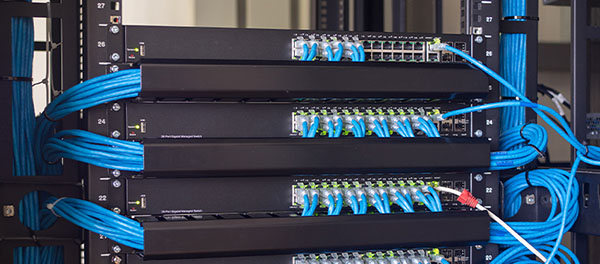

 Knowledge Base +
Knowledge Base +  2023.11.27
2023.11.27What is Structured Cabling?
Structured wiring refers to the building infrastructure designed to support the performance and reliability of a network. It encompasses a number of standardized smaller elements (structured) and various components, including cables, connectors, racks, and patch panels, all installed in a predefined hierarchical structure. This standardized approach enables efficient management and organization of network resources. At the same time, standardization of connectors and copper cabling performance categories and design guidelines have greatly simplified the planning and implementation of IT networks.

Structured Cabling VS Conventional Point-to-Point Cabling
Structured cabling is an organized approach to cabling infrastructure. To completely grasp this concept, it is important to first consider what non-structured cabling is. In many data centers, the conventional cabling methodology used is defined as "point-to-point", also known as spaghetti cabling. That method runs patch cables (or "jumpers") directly to and from the hardware that needs connectivity. In this case, it often results in a complex and disorganized network infrastructure. As businesses grow and technology advancements continue, such cabling methods become increasingly inefficient and troublesome to manage.
However, in the structured wiring system, a series of patch panels and trunks are used to create a structure that allows for hardware ports to be connected to a patch panel at the top of the rack. That patch panel is then connected to another patch panel via a trunk (multi-fiber assembly designed for use in conveyance) in the MDA (Main Distribution Area). The MDA is the key aspect of structured cabling. This is where all the MACs (Moves, Adds, and Changes) can be made with short-length patch cords.
Structured cabling is a standardized and organized approach to designing and managing the cabling infrastructure within a networking system. It provides a comprehensive and uniform system that supports various hardware uses, such as computers, telecommunication equipment, and other devices. The primary goal of structured cabling is to create a flexible and scalable network infrastructure that can accommodate changes and upgrades with minimal disruption.
Key components and characteristics of structured cabling include:
Standards-Based Design: Structured cabling follows industry standards set by organizations like the Telecommunications Industry Association (TIA) and the International Organization for Standardization (ISO). These standards ensure compatibility, reliability, and interoperability of cabling components.
Unification of Cabling Elements: Structured cabling integrates different types of cabling, such as data, voice, and video, into a single, cohesive system. This unification simplifies management and reduces the need for multiple, independent cabling systems.
Modularity and Scalability: Structured cabling is designed to be modular and scalable, allowing for easy expansion and modification. This flexibility is crucial as businesses grow or change their infrastructure requirements.
Centralized Management: The cabling infrastructure is typically organized around a central point called the Main Distribution Frame (MDF) or Main Cross-Connect (MC), which serves as the central point for connecting various network devices and services.
Cable Subsystems: Structured cabling includes various subsystems, such as entrance facilities, equipment rooms, backbone cabling, telecommunications rooms, and horizontal cabling. Each subsystem plays a specific role in creating a comprehensive cabling infrastructure.
Cabling Components: The cabling components in a structured cabling system include cables, connectors, patch panels, and other hardware. These components are chosen based on performance, compatibility, and adherence to industry standards.
Support for Multiple Applications: Structured cabling supports various applications, including data, voice, video, and multimedia. This versatility allows organizations to use a single cabling infrastructure for diverse communication needs.
Advantages of structured cabling include easier troubleshooting, simplified maintenance, improved scalability, and reduced downtime during modifications or upgrades. It provides a solid foundation for current and future communication needs within an organization.
Subscribe to the newsletter
for all the latest updates.
2-5# Building, Tongfuyu Industrial Zone, Aiqun Road, Shiyan Street, Baoan District, Shenzhen. China
